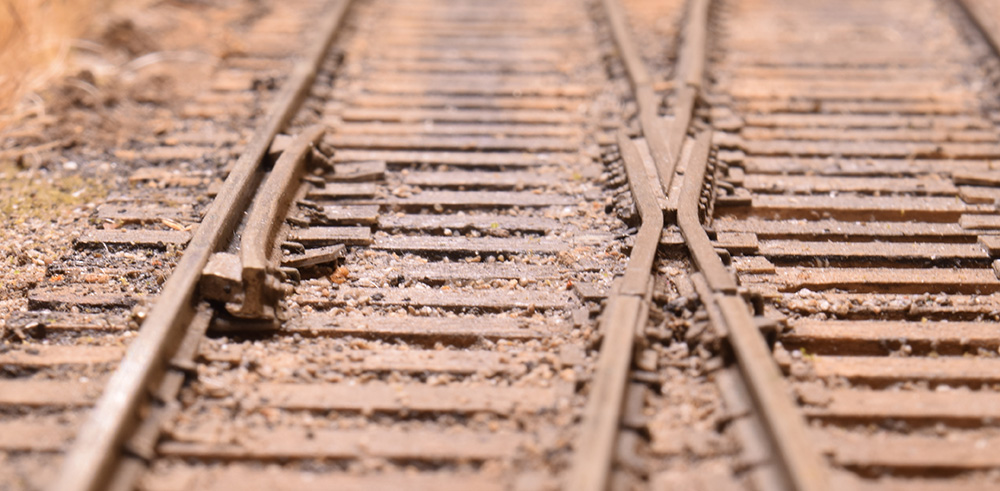One of the true joys of using Proto48 standards is the ability to have scale width flange ways at switch points, frogs, guard rails and grade crossings or street trackage.
It may seem like a small thing but these finer tolerances create a tremendous level or realism to the scene.


Above and below, comparing the model to actual track shows how the scale width of the flange ways adds greatly to the atmosphere of the scene.


As we know, track and wheels are an integrated system, where all aspects work together. Modifying one part impacts the rest. Wheels with scale dimensions require flange ways that are properly sized. Given the oversized standards most of us are used to, scale flange ways look impossible for a wheel to navigate, yet they work just fine. I’ve handlaid track to finescale dimensions in HO and quarter-inch scales and in my experience, it isn’t any harder than regular track work even though many people struggle with the finer tolerances. There is a bit more filing to do and the fit needs extra care. However, it’s all possible for a modeler with average skills and the determination to keep after it. Proto48 makes the job simpler by virtue of the fine cast frogs, guardrails and switch points that are available from Right-O-Way products. However, at the end of the day, you know what gives you enjoyment in this craft better than I do, so make your choices accordingly.
It’s true that such standards aren’t for every taste, as we each bring different sensibilities and goals to the craft. I’ve always wanted to model track to this degree. I view the work as an end in itself and get genuine pleasure from the effort and the finished product. That’s me however, your experience will be different for certain.
Regards,
Mike
Related items that may be of interest.
(Please note my supplies are very limited as of May 1, 2023. Once the current print run is gone, it will not be repeated in print form.)
The Missing Conversation Vol. 07
This ebook looks at the differences in track for different eras.
The go -to resource of supplies for modeling track in quarter-inch legacy scale and Proto48.
Disclosure note. The two books are my own and available on this site. Right-O-Wy also carries copies of Detailing Track for sale. I have no other affiliation with ROW beyond being a satisfied customer. I list them here as I can recommend their products wholeheartedly.
I have worked to “proto”* track and wheel standards since my late teens, and never regretted it.
One thing in the favour of adopting these standards is that the prototype has had over 200 years of world-wide practical experience creating and refining the dimensions. If you simply take those real measurements and divide by your scale ratio, then other than a very minor adjustment of no more than 0.001” here and there to keep things within manufacturing tolerances and to avoid cumulative rounding errors, you don’t have to think about it any further.
To create a balanced set of standards to suit wider flanges, etc, means getting into a fair bit of maths and applying various rules, checks and balances, and then increased difficulties in manufacturing/making models to accommodate these alterations – the “O5W” in North American 1:48 0 scale on 1.25” gauge track, or the reduced back-to-back in British “finescale”* 0 gauge, to 7mm scale on 32mm gauge track, where cutouts are required for driving wheels under steam loco boilers. Or there are created semi-fine halfway house solutions, such as “code 88” wheels for H0, which sort of works, but not as a substitute for correct profile (“code 87”) wheels in S scale, as the code 88 flange is wider than for code 87, and this creates other problems, which is,probably outside of this blog or comment, but it illustrates the point: misapplication of one standard to another purpose as a convenience means not applying the correct principles, which leads to bad running not because the idea is wrong, but because the implementation was flawed.
My point here is that doing things to an accurate scale ratio is simpler in the long run: filing rail for crossings and switches is the same no matter what standards, and the use of various gauges to set key dimensions (track gauge, guard rails, etc) is essential for any set of track standards. Yes, one eschews ready made track, but as soon as one studies the prototype carefully, then that becomes necessary anyway. But manufacturers in many scales also provide castings and assemblies for switches and crossings to the correct proportions, so if hand-laying turnouts anyway, this is no harder than to any other standard.
If your primary focus is to hustle long trains – and lots of them – over a densely packed network in your basement empire, then rewheeling your equipment might be daunting and costly, but using a single, consistent profile that is matched to the track provides for better running, too, so why not do it right? (Or possibly, one’s interest is not really in modelling the things that make a Railway what it is – the flanged wheel on a tracked road – but in the operation of the trains. In which case, you probably aren’t a regular reader of this blog.)
And a plug for my friend here: the book is excellent (I said so in 2013 and have no reason to change my mind: https://ewjr.org/2013/09/10/intelligent-discussion/ ), as are Jay’s products, for that matter.
Simon
* Because of the use in the UK at least of “finescale” to sometimes mean something between the RTR standards and prototype-derived standards, I have tried not to use this word. The most common 7mm scale standard gauge standards are now usually called “0F” for “O fine” over here, as for gauge 1: G1F. They are really “finer than coarse” rather than fine, and I personally think this is misleading.